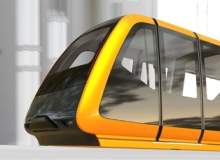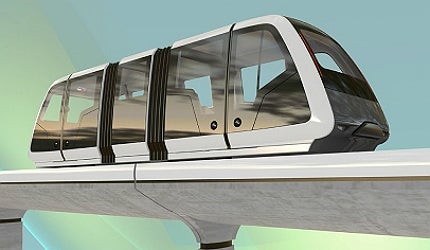

Later this year, a joint partnership between Vectus Intelligent Transport and design firm Pininfarina – best known for its slick Ferrari designs – will launch its first commercial Personal Rapid Transport (PRT) system in South Korea.

Discover B2B Marketing That Performs
Combine business intelligence and editorial excellence to reach engaged professionals across 36 leading media platforms.
The one-car rail pods have just made their world debut at the Pininfarina exhibition at the Italian Cultural Institute in London, where a 1:18 scale model was on display. The on demand system uses "small, light and driverless vehicles" to navigate a "network of interconnecting tracks". Passengers travel from one point to another without mandatory stops in between, thus optimising travel time.
The newly-designed PRT pods will be statically tested in the UK, then shipped to a new test-track facility in Suncheon.
Following a period of operational testing and certification by the Korean authorities, 40 vehicles will be produced and delivered providing a tourist link along ten kilometres of track between Suncheon and a world famous wetlands bird reserve to the south of the Korean peninsula.
Designing personal rapid transport the Pininfarina way
According to Pininfarina’s chief designer, Paolo Trevisan, one of the partnership’s biggest challenges was to find the right balance between creating a very iconic object and being able to place that object harmoniously into the urban environment.

US Tariffs are shifting - will you react or anticipate?
Don’t let policy changes catch you off guard. Stay proactive with real-time data and expert analysis.
By GlobalDataThe team chose to create smooth and rounded shapes that could be integrated in different contexts while remaining faithful to Pininfarina’s values of innovation, purity and elegance. "A project like Vectus PRT requires a high level of flexibility because it can be introduced into environments that are very different from the urban point of view and from the aesthetic sensibility," said Trevisan.
The guidelines for the vehicle’s design were forged out of a desire for simplicity and universality, but the team also wanted to create a particular identity for the pod car.
"We didn’t want it to be too similar to a car or tram, but it had to have a distinctive character," said Trevisan.
"Talking about the exterior design, the focal element of the project is the ring around the doors that gives identity and flexibility to the project. The customisation of the ring is a further characterising element.
Moreover the external shape also transmits the message of solidarity, safety and reliability – these are among the main characteristics of this urban transport solution."
Accessible and flexible, inside and out
While the pod design has attracted much attention by itself, Vectus insists that it is important to view the company’s PRT system as a turnkey transit solution, with the design ensuring each passenger experiences a seamless and comfortable journey.
It was in 2010 that the company approached Pininfarina to work as the design partner on all aspects of the passenger’s experience, working not only on the pods, but on the stations and track profiles as well.
Good accessibility was one of the most important elements to master during the design process. "The goal was to guarantee an easy way to enter and exit the pod car and the solution was to take particular care of the design of the doors," said Trevisan. They have been designed to be high and large enough to make access comfortable not only for standing people – without the necessity of bending to enter and exit – but also for disabled people or those with bikes."
Overall the PRT vehicles are modular in design so that they can be varied in size to carry between six and sixty passengers, depending on the requirements of a specific project. The interior design of the vehicles will comfortably accommodate six people and has been made from materials that will enable maximum hygiene. Large windows have also been implemented, which allow the passengers to enjoy the view.
"Similar to a Formula One race car, all the body frames and panels are manufactured in carbon fibre composites," said Martin Pemberton, sales and marketing director at Vectus Ltd.
"The main driver is strength-to-weight ratio in order to optimise performance and minimise energy consumption. Some of the mouldings are hollow, using the same ‘monolithic’ moulding technology employed for manufacturing the likes of turbine blades or bicycle frames. This provides the necessary high degree of structural integrity to meet international safety standards."
An emerging PRT future
According to Pemberton, the company has been researching the PRT field for more than ten years, which finally culminated in the construction of a fully operational test track in Sweden in 2007.
"We believe there is a huge future for PRT in emerging economies where there is little existing infrastructure and an urgent requirement to install low cost, energy efficient transport systems on a countryside basis," said Pemberton, adding that several million dollars have been invested in the company’s PRT technology.
"Vectus is arguably the most cost-effective public-transit solution for moving up to around ten thousand passengers an hour. Thereafter you need to be considering a more traditional, mass-transit mode."
Offline stations, on-demand operation, point-to-point travel and ‘taxi’ style comfort and convenience are all features of the system. "It is designed to enhance and improve the viability of such networks by providing feeder lines and links into areas where ‘heavy rail’ would otherwise be too expensive to install and operate," said Pemberton. "PRT can also provide the ‘last mile’ of transportation, say from a busy railway station, which might otherwise involve a taxi ride or bus."





